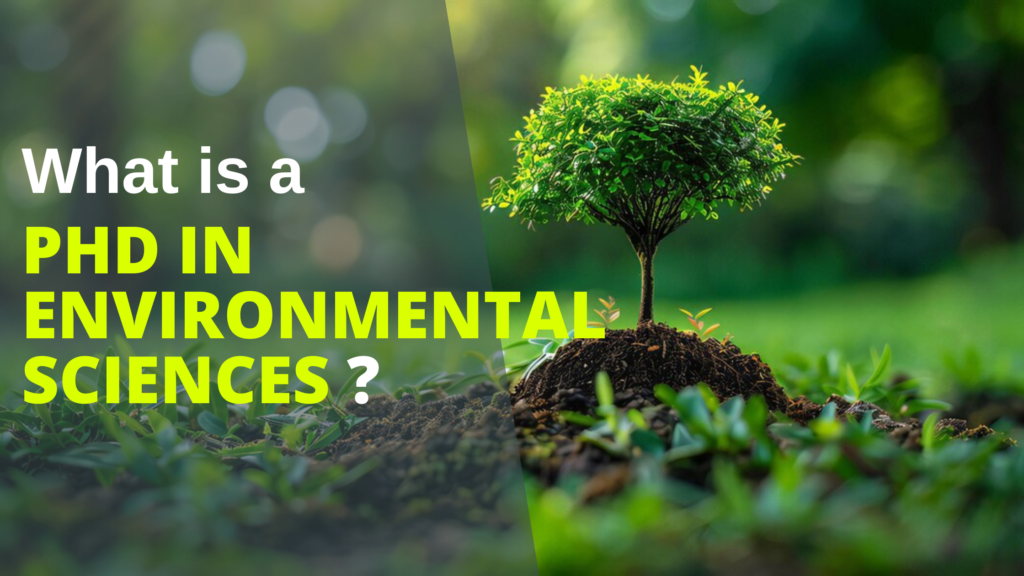Depending on what you want to do with your career, a PhD in Environmental Sciences may seem like the right choice. The good news is that this type of degree can help you get there. In fact, many professionals who have earned their doctorates in environmental science found jobs related to their research as soon as they graduated. As long as you follow these steps when applying for a PhD program, getting accepted into an environment-based program should be easier than ever before
Table of Content
Course Highlights
- The time it takes to complete your PhD in Environmental sciences depends on the school and program. A typical timeline for a PhD in Environmental sciences at an American university could be anywhere from 5 years to 6 years, with an average of 5 years.
- However, this is not an exact science and varies greatly depending on factors such as your academic background, how long you’ve been working on your topic or project (if any) before starting graduate school, and whether or not there are other commitments keeping you from fully dedicating yourself to this area of study.
- The most important factor that determines how long it takes for students to earn their bachelor’s degree has nothing to do with their ability but rather how many courses they take each semester vs those who only take one course per semester (and even then sometimes struggle).
- Most universities offer both options along with others like online learning environments so there should be some flexibility within these options no matter what type of learner wants more flexibility when it comes time for finishing up their studies
Features of PhD in Environmental Sciences
- A PhD in Environmental Sciences is a terminal degree, which means it’s the highest level of education you can achieve. It’s not necessary to have this type of degree before applying for jobs or interviewing with prospective employers. In fact, many employers won’t even look at candidates who don’t have one!
- However! While this might seem like a disadvantage, there are some advantages to being an expert in your field and being able to prove it on paper.
- The most important benefit is that people will trust your judgment when making decisions about their workplace environments—which means more opportunities for advancement as well as higher salaries!
Course Duration

If you are interested in environmental sciences, and especially if you want to study climate change, it’s important to note that a PhD will require a master’s degree from an accredited college or university.
However, students can work on their MS while they do their PhD. This is because many universities offer courses for students who want to earn an MS as part of their doctoral program.
Some programs may require all PhD candidates to take these courses before beginning their research; others may allow students who want extra flexibility in scheduling or commuting time between home and school (or both) access them at any point during their studies.
Dissertation Report
A PhD student will conduct original research related to his or her dissertation topic. A dissertation is a research paper or thesis that summarizes the results of a student’s work and provides the basis for future academic work. It’s required for students who wish to earn their PhDs, but it is not required if you only want an MSc degree from our institution (see below).
A doctoral student will conduct original research related to his or her dissertation topic. A dissertation is a research paper or thesis that summarizes the results of a student’s work and provides the basis for future academic work. It’s required for students who wish to earn their PhDs, but it is not required if you only want an MSc degree from our institution (see below).
Career Prospects
- An individual who earns a PhD in environmental sciences can work as a researcher, teacher, or administrator.
- Research scientists conduct experiments and write reports about them; teachers teach students about the subject matter of their field; administrators oversee an organization’s day-to-day operations; consultants advise businesses or organizations on how to improve their practices or strategies.
- Policy analysts help create policies that affect public health through legislation and regulation at both federal and state levels (such as the Clean Air Act).
- Policy makers formulate new laws by making recommendations to Congress or other elected officials in Washington DC.
- They also make decisions about which projects should receive funding from government agencies like the National Science Foundation (NSF), NASA Space Agency Management Office (NMAO) and Environmental Protection Agency (EPA).
- Policy advisors work with legislators during debates over proposed legislation before it goes into effect—they’re responsible for helping lawmakers understand what they’re voting on so they can make informed decisions based on facts rather than personal preference alone!
- Advocates also play an important role: they help citizens understand what needs changing so everyone benefits instead just certain groups.
If you want to do research related to the environment, an environmental sciences PhD can help you get there.
Research is a very important part of environmental sciences. A PhD is a good way to get into research and it’s also considered by many employers as being a good way of becoming an environmental scientist or ecologist.
Summing Up
The PhD in environmental sciences is a great option for people who want to pursue scientific research and make a career out of it. The program provides comprehensive training that prepares students for careers in academia, government agencies, consulting firms and more. The most important thing to remember when considering this degree is that you’ll need time to complete your studies because they can take 5-6 years!




